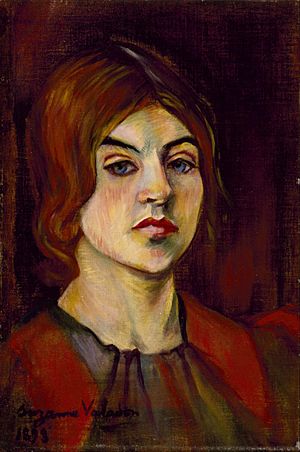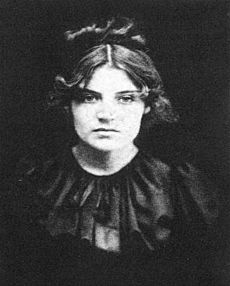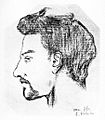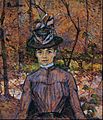Suzanne Valadon facts for kids
Quick facts for kids
Suzanne Valadon
|
|
|---|---|

Self-portrait, 1898, Museum of Fine Arts Houston
|
|
| Born |
Marie-Clémentine Valadon
23 September 1865 Bessines-sur-Gartempe, France
|
| Died | 7 April 1938 (aged 72) Paris, France
|
| Nationality | French |
| Known for | Painter |
| Movement | Post-Impressionism, Symbolism |
| Spouse(s) | Paul Mousis, André Utter |
| Partner(s) | Erik Satie, Henri de Toulouse-Lautrec |
Suzanne Valadon (born Marie-Clémentine Valadon; 23 September 1865 – 7 April 1938) was a famous French painter. She was born in Bessines-sur-Gartempe, France. In 1894, Valadon made history by becoming the first woman painter accepted into the Société Nationale des Beaux-Arts. She was also the mother of another well-known painter, Maurice Utrillo.
Valadon worked as an artist for almost 40 years. Her drawings and paintings often showed women, everyday objects (called still lifes), and outdoor scenes (landscapes). One of her famous paintings is Joy of Life (1911). She never went to an art school. This meant her art was unique and didn't follow strict rules.
Before she became a painter, Valadon was a model for many famous artists. She appeared in paintings like Dance at Bougival (1883) by Pierre-Auguste Renoir. She also modeled for Dance in the City (1883) by Renoir and Suzanne Valadon by Henri de Toulouse-Lautrec.
Contents
Early Life and Work
Suzanne Valadon grew up in a poor family in Montmartre, Paris. Her mother was a laundress and raised Suzanne alone. Suzanne was very independent and didn't like to follow rules. She went to primary school until she was eleven. Then, she started working to help her family.
She had many different jobs. She worked in a hat shop, a factory, and sold vegetables. She even worked as a waitress. When she was 15, she got a job she really wanted: performing in the circus as an acrobat. She worked at the Medrano circus, which was popular with artists like Toulouse-Lautrec. Sadly, her circus career ended after only one year. She hurt her back in a fall from the trapeze.
It is believed that Valadon taught herself to draw when she was nine. In Montmartre, she followed her interest in art. She couldn't afford art lessons. So, she started working as a model for artists. By watching them, she learned their painting techniques. She learned from artists like Pierre Puvis de Chavannes, Henri de Toulouse-Lautrec, and Pierre-Auguste Renoir. Eventually, she became a successful painter herself.
Becoming a Model

Valadon started modeling in Montmartre in 1880 when she was 15. For over ten years, she modeled for many artists. These included Berthe Morisot, Pierre Puvis de Chavannes, Théophile Steinlen, Pierre-Auguste Renoir, and Henri de Toulouse-Lautrec. She was first known as "Maria." But Toulouse-Lautrec nicknamed her "Suzanne." He thought she was like the biblical story of Susanna and the Elders.
Valadon improved her art skills by watching the artists she posed for. People described her as focused, ambitious, and confident. In the early 1890s, she became friends with Edgar Degas. He was very impressed by her bold drawings and beautiful paintings. Degas bought her artwork and encouraged her. They remained close friends until he passed away in 1917.
One of the most famous early paintings of Valadon is Renoir's Dance at Bougival from 1883. She also posed for his Dance in the City in the same year. In 1885, Renoir painted her again in Girl Braiding Her Hair. Another portrait from 1885 shows her head and shoulders in profile.
Valadon as an Artist
Valadon was a respected painter during her time. Artists like Edgar Degas and Pierre-Auguste Renoir admired her work. She joined professional art groups and her paintings were chosen for important exhibitions. She lived a free-spirited life and had a unique artistic vision.
Her earliest known artwork is a self-portrait from 1883. It was drawn with charcoal and pastel. From 1883 to 1893, she mostly created drawings. She started painting in 1892. Her first models were her family, especially her son, mother, and niece.
Valadon began painting full-time in 1896. She painted still lifes, portraits, flowers, and landscapes. Her works are known for their strong design and bright colors.
She often showed her art at the Galerie Bernheim-Jeune in Paris. In 1894, Valadon was accepted into the Salon de la Nationale. This was a big achievement because it was very hard to get in.
She also exhibited her work in other important shows. These included the Salon d'Automne (from 1909) and the Salon des Indépendants (from 1911). Degas was the first person to buy her drawings. He also introduced her to other art collectors. Degas even taught her how to do soft-ground etching.
After marrying Paul Mousis in 1896, Valadon focused completely on painting. She shifted from drawing to painting around 1909. Her paintings for the Salon include Adam and Eve (1909) and Joy of Life (1911). She also painted Casting the Net (1914). During her life, Valadon created hundreds of drawings, paintings, and etchings.
Valadon was well-known, especially later in her career. Her artworks are now in major museums. These include the Centre Georges Pompidou in Paris and the Metropolitan Museum of Art in New York.
Artistic Style
Valadon didn't stick to one specific art style. However, her work shows elements of Symbolism and Post-Impressionism. She mostly used oil paint, oil pencils, pastels, and red chalk. She liked these materials because they were not too watery. Valadon's paintings use rich colors and bold brushstrokes. She often used strong black lines to outline her figures.
Her self-portraits, portraits, landscapes, and still lifes were unique. They didn't follow the popular art trends of her time. She preferred to paint models who were working-class people.
Valadon believed that the overall design of her portraits was most important. She focused less on details like expressive eyes. Her later paintings, such as Blue Room (1923), have brighter colors. They also show more detailed backgrounds and patterned fabrics.
Personal Life
In 1883, when she was 18, Valadon had a son named Maurice Utrillo. While Valadon returned to modeling, her mother took care of Maurice. Later, Valadon's friend Miquel Utrillo recognized Maurice as his son.
In 1893, Valadon had a relationship with the composer Erik Satie. She lived near him for a short time. Satie was very fond of her. He wrote many notes about her, calling her his Biqui. After six months, she left, which made him very sad.
Valadon married Paul Mousis, a stockbroker, in 1895. They lived together for 13 years in Paris and in a country house. In 1909, Valadon started a relationship with painter André Utter. He was 23 years old and a friend of her son. Utter became a model for her. He appears as Adam in her painting Adam et Eve, painted that same year. She divorced Mousis in 1913. Valadon then married Utter in 1914. Utter helped manage her art career and her son's. Valadon and Utter often showed their art together. They divorced in 1934, when Valadon was almost 70. However, they remained close until her death and are buried together in Paris.
Exhibitions and Collections
Suzanne Valadon's work was shown in many group and solo exhibitions throughout her life. After her death, her art continued to be featured in important shows around the world. Her paintings are part of the permanent collections of many famous museums. These include the British Museum in London, the Metropolitan Museum of Art in New York, and the Museum of Modern Art in New York.
Gallery
Artwork by Valadon
Portraits of Valadon
-
Portrait of Suzanne Valadon, 1885, by Henri de Toulouse-Lautrec
-
Miquel Utrillo i Morlius: Portrait of Suzanne Valadon (1981), Museu del Cau Ferrat, Sitges.
Legacy
Suzanne Valadon's legacy lives on in several ways. An asteroid (6937 Valadon) and a crater on Venus are named in her honor. In Paris, a small square at the base of the Montmartre funicular is called Place Suzanne Valadon. Nearby, steps are named rue Maurice Utrillo after her son.
Her life has also inspired books and plays. For example, Elaine Todd Koren wrote a novel about her called Suzanne: of Love and Art.
Death
Suzanne Valadon passed away from a stroke on 7 April 1938. She was 72 years old. She was buried in the Cimetière de Saint-Ouen in Paris. Many famous artists attended her funeral, including André Derain, Pablo Picasso, and Georges Braque.
See also
 In Spanish: Suzanne Valadon para niños
In Spanish: Suzanne Valadon para niños
- Musée de Montmartre, a museum located in the building where Valadon once lived and worked.



















